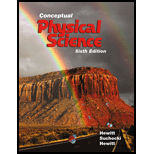
Which would you expect to have a higher melting point: sodium chloride, NaCl, or aluminum oxide, Al2O3?
(a) Aluminum oxide, because it is a larger molecule and has a greater number of molecular interactions
(b) NaCl, because it is a solid at room temperature
(c) Aluminum oxide, because of the greater charges of the ions and hence the greater force of attraction between them
(d) Aluminum oxide, because of the covalent bonds within the molecule
Want to see the full answer?
Check out a sample textbook solution
Chapter 15 Solutions
Conceptual Physical Science Plus Mastering Physics with Pearson eText -- Access Card Package (6th Edition)
Additional Science Textbook Solutions
Modern Physics
Sears And Zemansky's University Physics With Modern Physics
Physics (5th Edition)
Glencoe Physical Science 2012 Student Edition (Glencoe Science) (McGraw-Hill Education)
Life in the Universe (4th Edition)
Lecture- Tutorials for Introductory Astronomy
- Your roommate is having trouble understanding why solids form. He asks, "Why would atoms bond into solids rather than just floating freely with respect to each other?" To help him understand at least one type of bonding in solids, you decide to embark on an energy explanation. You show him a drawing of a primitive cell of a sodium chloride crystal, NaCl, or simple table salt. The drawing is shown in the figure below, where the orange spheres are Na+ ions and the blue spheres are Cl− ions. Each ion has a charge of magnitude equal to the elementary charge e. The ions lie on the corners of a cube of side d. You explain to your roommate that the electrical potential energy is defined as zero when all eight charges are infinitely far apart from each other. Then you bring them together to form the crystal structure shown. a) Evaluate the electric potential energy of the crystal as shown.arrow_forwardHow can you separate salt from three salty chicken wings? Write a procedure that can give you an estimate of the gram of NaCl per chicken wing?arrow_forwardWhy do molecular compounds have low melting and boiling points compared to ionic compounds?arrow_forward
- Q. 2. Calculate the packing efficiency and density of sodium chloride from the following data: Radius of sodium ion= 0.98 A Radius of chloride ion= 1.81 A Atomic mass of sodium= 22.99 amu Atomic mass of chloride= 35.45arrow_forwardWhy do ionic compounds have high melting and boiling points?arrow_forwardA sample of HCl gas is placed in an electric field of 3×104NC−1. The dipole moment of each HCl molecule is 3.4×10−30Cm. Calculate the maximum torque experienced by each HCl molecule.arrow_forward
- A student is carrying out a biological preparation that requires 1 M NaCl tomaintain an ionic strength of 1.0. The student chooses to use 1.0 M ammonium sulfate instead. Why is this a serious error?arrow_forwardThe molecule bromine monofluoride has a dipole moment of 1.42 D and a bond length of 176 pm. Calculate the charge on the ends of the molecule. Express your answer as a positive real number in electronic charge units (e = 1.60 × 10-19 C).arrow_forwardwhat is a reasonable value for the charge of a molecule after several electrons are stripped from it? a) 10^19 C b) 10^-18 C c) 10^10 C d) 10^-9 Carrow_forward
- The internuclear distance (bond length) of carbon monoxide molecule is 1.13 Å. Calculate the energy (in joules and eV) of this molecule in the first excited rotational level. Also calculate the angular velocity of the molecule. Given atomic masses of 12^C = 1.99x10^-26 kg; 16^O = 2.66x10^-26 kg.arrow_forwardMany dry cereals are fortified with iron, which is added to the cereal in the form of small iron particles. How might these particles be separated from the cereal?arrow_forwardIf an electron is removed from each molecule, it is observed that N2+ has a weaker bond than N2, but O2+ has a stronger bond than O2. Explain why electron removal has a different effect on these two molecules.arrow_forward
 An Introduction to Physical SciencePhysicsISBN:9781305079137Author:James Shipman, Jerry D. Wilson, Charles A. Higgins, Omar TorresPublisher:Cengage Learning
An Introduction to Physical SciencePhysicsISBN:9781305079137Author:James Shipman, Jerry D. Wilson, Charles A. Higgins, Omar TorresPublisher:Cengage Learning Physics for Scientists and Engineers with Modern ...PhysicsISBN:9781337553292Author:Raymond A. Serway, John W. JewettPublisher:Cengage Learning
Physics for Scientists and Engineers with Modern ...PhysicsISBN:9781337553292Author:Raymond A. Serway, John W. JewettPublisher:Cengage Learning Modern PhysicsPhysicsISBN:9781111794378Author:Raymond A. Serway, Clement J. Moses, Curt A. MoyerPublisher:Cengage Learning
Modern PhysicsPhysicsISBN:9781111794378Author:Raymond A. Serway, Clement J. Moses, Curt A. MoyerPublisher:Cengage Learning



